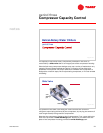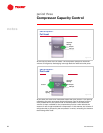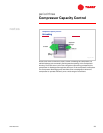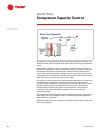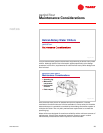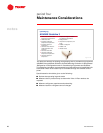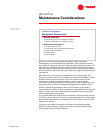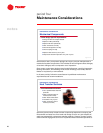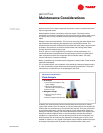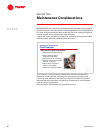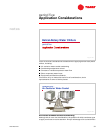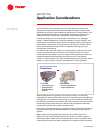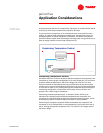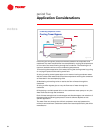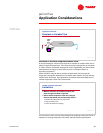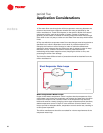
TRG-TRC012-EN 29
period four
Maintenance Considerations
notes
determine the level of water treatment required to remove contaminants from
the cooling tower water.
Scale deposits are best removed by chemical means. The water-cooled
condenser is commonly isolated from the rest of the cooling tower water circuit
by valves, and a pump circulates cleaning solution through the condenser
tubes.
Sludge is removed mechanically. This involves removing the water boxes from
the condenser and loosening the deposits with a stiff-bristled brush. The
loosened material is then flushed from the tubes with clear water. As part of this
procedure, the strainers on both the chilled water and cooling tower water
circuits should be cleaned every year.
Every 3 years, or more frequently for process or critical applications, it is
recommended that a qualified service organization perform non-destructive
tube inspections on both the evaporator and condenser tubes. The eddy-
current tube test is a common method.
Rarely, problems may arise that cause refrigerant or water leaks. These must be
repaired immediately.
For air-cooled chillers, the condenser coils should be cleaned at least annually
in order to maintain proper efficiencies and operating conditions. Follow the
manufacturer’s instructions to avoid damage to the coils.
Probably the most important annual maintenance task required for helical-
rotary water chillers is an oil analysis. It may be conducted more frequently for
chillers that run continuously or more often than normal. This test, performed
by a qualified laboratory, verifies the integrity of the refrigeration system by
testing the moisture, acidity, and metal concentration levels. This analysis can
determine where problems exist or could potentially develop. By taking oil
samples on a regular basis, normal operating trends for the compressor and
bearing metals can be analyzed. As opposed to changing the oil once a year
whether it needs it or not, regular oil analyses can be used to determine proper
oil change intervals as well as predict major problems before they occur.
maintenance considerations
Fluid Analysis
▲ Oil analysis
◆ Conduct annual analysis to verify
system integrity
◆ Measure oil pressure drop to
determine if filter needs changing
◆ Measure charge
▲ Refrigerant charge
◆ Measure charge and trim as
necessary
◆ Measure superheat and subcooling
Figure 43



